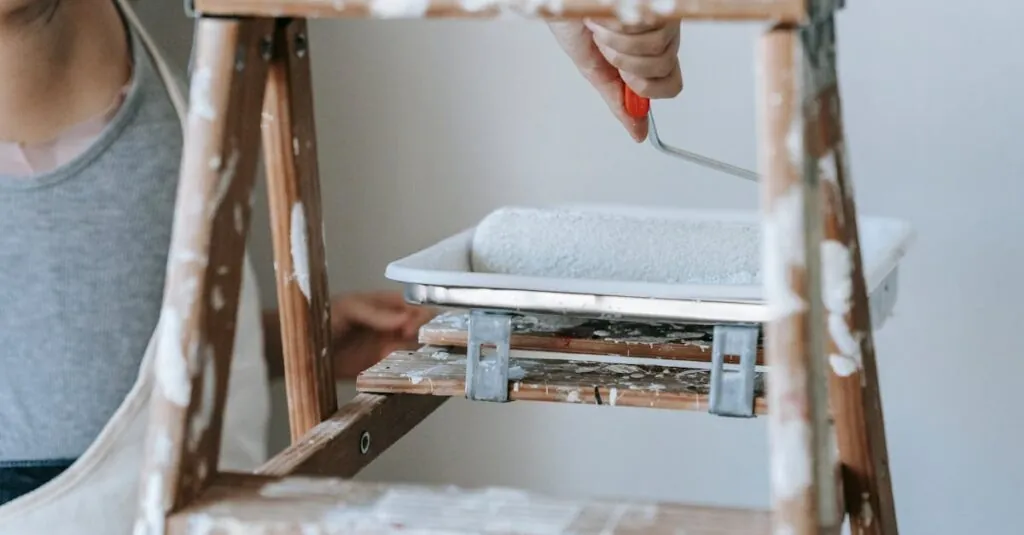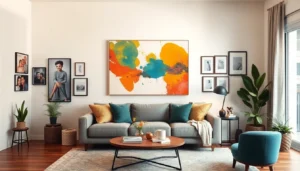Transforming a home studio isn’t just about slapping on a fresh coat of paint and calling it a day. It’s an adventure that can turn a cluttered corner into a creative haven. Whether it’s for music, art, or podcasting, a well-designed space can spark inspiration like a double shot of espresso on a Monday morning.
Imagine finally having the perfect backdrop for that viral video or a soundproof sanctuary where your neighbors won’t hear your questionable singing. With the right renovations, anyone can elevate their creative game. So grab your toolbox and let’s dive into the world of home studio renovation, where every nail and paint stroke brings you one step closer to your artistic dreams.
Planning Your Home Studio Renovation
Planning a home studio renovation involves assessing specific needs and setting clear goals. Consider what elements contribute to creativity and functionality in your unique space.
Defining Your Needs and Goals
Identifying specific needs starts with considering intended activities. For example, a musician might require soundproofing while a painter may focus on natural light. Establishing goals helps clarify what the ideal studio looks like. Incorporating storage solutions or choosing color schemes can enhance both aesthetic and functionality. Visualizing the finished product creates a clear roadmap for the renovation process. Individual preferences should guide decisions on layout and equipment.
Budgeting for Your Renovation
Creating a budget involves considering all potential costs associated with renovation. Allocate funds for materials, labor, and unexpected expenses that can arise. Research estimates for renovations tailored to space size and features. Prioritizing essential upgrades ensures resources focus on high-impact areas like acoustics for recording or workspace for art. Monitoring expenses against the budget maintains financial control. It’s wise to include a contingency fund of at least 10% to manage any unforeseen costs effectively.
Design Considerations
Designing a home studio involves several key factors that influence functionality and creativity. Attention to specific needs leads to a more effective and inspiring space.
Choosing the Right Space
Selecting the optimal area for a studio significantly impacts overall functionality. First, consider the primary activities intended within that space. If recording music, prioritize sound isolation; if painting, maximize natural light. A quiet corner away from distractions often works best for focused work. Evaluate the room’s dimensions, as a larger area allows for flexible setup options. Accessibility also matters, so ensure the space is easy to navigate. Check for existing features, such as windows or built-in shelves, which can enhance the studio’s layout.
Acoustic Treatment Solutions
Incorporating acoustic treatment improves sound quality drastically. Identify common issues like echoes and external noise interference. Foam panels can absorb unwanted sound reflections effectively. Bass traps address low-frequency sounds that often muddle recordings. Decoupling techniques can further isolate sound sources to minimize interference. Using thick carpets or rugs dampens noise and adds comfort to the space. Curtains or movable partitions can also help control sound reflections without permanent alterations. Remember, investing in quality acoustic materials directly affects the studio’s productivity and output quality.
Essential Equipment for Your Home Studio
Creating a fully functional home studio demands a selection of essential equipment tailored to specific artistic needs.
Recording Gear
Recording gear forms the backbone of any home studio. A high-quality microphone captures vocals or instruments with clarity. Producers often prefer dynamic or condenser microphones based on the recording environment. Audio interfaces connect microphones and instruments to computers, enabling seamless audio transfer. Investing in a reliable digital audio workstation (DAW) software allows for efficient recording, editing, and mixing. Headphones also play a crucial role, providing accurate sound monitoring. Choosing closed-back headphones minimizes outside noise, enhancing focus during recording sessions.
Mixing and Mastering Equipment
Mixing and mastering equipment elevates audio quality to professional standards. Studio monitors deliver precise sound reproduction, essential for making informed audio decisions. Selecting monitors with sufficient frequency response ensures balanced sound across low, mid, and high frequencies. Additionally, outboard gear like equalizers and compressors can refine audio tracks. These tools help shape the sound by controlling dynamics and enhancing frequencies. A well-calibrated control surface streamlines the mixing process, allowing for tactile adjustments. Utilizing plug-ins can further fine-tune mixes, offering a broad range of creative possibilities.
DIY vs. Hiring a Professional
Deciding between a DIY renovation or hiring a professional defines a crucial step in transforming a home studio. Both options have benefits and drawbacks worth considering.
Pros and Cons of DIY Renovation
Engaging in a DIY renovation tends to save money, allowing for cost-effective solutions. Achieving personal satisfaction from completing tasks independently provides motivation. However, lacking experience can result in mistakes that require fixing, ultimately costing more in the long run. Mastering construction skills can take time, delaying the project. Evaluating one’s capabilities becomes essential; a clear understanding of personal skills fine-tunes decision-making regarding the DIY route.
When to Hire a Contractor
Hiring a contractor streamlines the renovation process, offering expertise that often leads to impressive results. Professional contractors possess experience with specific tasks, reducing the likelihood of errors. They navigate building codes and permit requirements, ensuring compliance throughout the project. If the renovation involves significant structural changes, like soundproofing, seeking professional help eases concerns. When time constraints exist, hiring a professional speeds up the process, allowing a quality studio space sooner.
Conclusion
Transforming a home studio is an exciting journey that can unlock creativity and enhance productivity. By carefully planning the renovation process and considering personal needs and goals, anyone can create a space that inspires artistic expression.
Investing in quality equipment and soundproofing solutions is essential for achieving professional results. Whether opting for a DIY approach or hiring a professional, the key is to stay focused on the vision and ensure every aspect aligns with the intended purpose of the studio.
With thoughtful design and strategic planning, a home studio can become a sanctuary for creativity and innovation. Embrace the renovation journey and watch artistic aspirations come to life.





